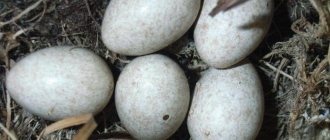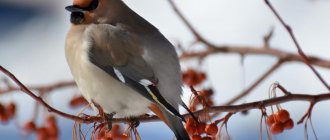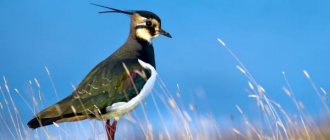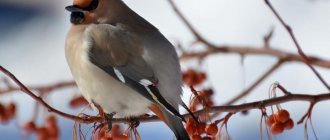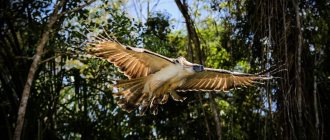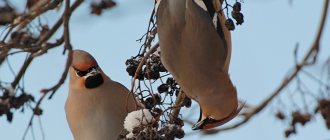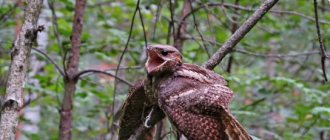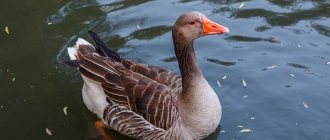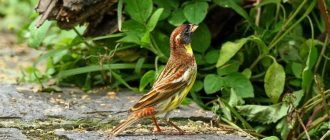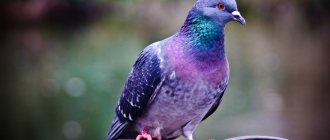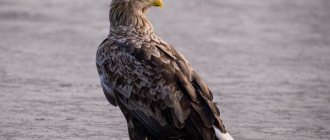Great tit
- Fact 1:
Ornithologists recognize more than 28 species with geographic and environmental variability. - Fact 2:
Those who consider the tit a migratory bird are mistaken. She remains at the nesting site for the winter. - Fact 3:
In summer, tits have a varied menu, but in autumn and winter, plant foods predominate. - Fact 4:
In ancient times in Russia there was a decree that subjected anyone who encroached on the life of a tit to a huge fine
The tit is a bird from the passerine order with a characteristic yellow belly. The second name is the great tit, big tit, Parus major (in Latin). Who doesn't know this yellow bird? Everybody knows! The tit bird is very nimble, nimble, spins and moves as if wound up, makes sudden funny movements.
| The titmouse got its name from the sounds of its chirping “tswin-tswin”, “tsin-tsin”, “tsviu-tsviu”. |
By nature, she is resourceful, but quite timid. It will fly to the side 10 times before it comes close.
In one thousand seven hundred and fifty-eight, the Swedish botanist and zoologist Carl Linnaeus first described the great tit in detail and gave it a Latin name.
Ornithologists recognize more than 28 species , differing in geographical and environmental variability. For example, the great tit and blue tit have biological characteristics. There are also Muscovy, Chickadee, Chickadee, Tufted Tit and others.
The lively and inquisitive bird belongs to the tit family, the order of passeriformes.
Appearance
This yellow-breasted bird is the smallest of its genus, measuring only 15-16 cm in length. It has a slender body with a long tail that sways from side to side. The chest plumage of males is always brighter than that of females. The color of the back can vary from grayish-green to grayish-brown with a slight olive tint. The feathers located on the flight parts of the wing are light brown, with a reddish rim. The tail is dark and brown. The head pattern depends on the subspecies of yellow wagtail. So, for example, birds living in the Volga region or in South-Western Siberia “wear” a grayish-yellow “cap” on their heads, while wagtails in the south (Crimea) have an almost black top. White linear patterns often exist above the eyes. The chin and front of the neck range from bright yellow to white.
Natural enemies of wagtails
Since the wagtail is very small in size and does not have sharp poisonous teeth, it has a lot of ill-wishers in the wild. She is threatened by predatory animals:
- caresses;
- martens;
- feral and domestic cats;
- ferrets.
Large birds also pose a danger:
- owls;
- crows;
- kites;
- eagles;
- hawks.
Owls and eagle owls are especially dangerous for wagtails, as they attack them at night during migratory flights.
Owls attack migrating wagtails at night
Wagtails, despite their tiny size, are very brave and courageous creatures. They bravely defend themselves from ill-wishers. The birds know that alone they will never drive away the enemy, therefore, seeing that one of their relatives is in danger, dozens of wagtails flock to his aid. Together they begin to emit a piercing, unpleasant squeak to scare the offender. Quite often this technique works, and the predatory animal or bird runs away rather than hear this loud sound.
Birds that live in populated areas are most often threatened by man himself and his activities.
Spreading
The wagtail lives in Russia almost everywhere, with the exception of some places: the tundra, southern Sakhalin and the Caucasus. Also likes to nest in most of Eurasia, except the Far North, Southeast Asia, western Alaska of North America and mountain systems. In addition, the owner of the yellow breast is a migratory bird and visits nesting sites from April to the first or second month of autumn. It prefers to winter in Africa, the Philippines, South Asia and the Malay Islands.
Exotica in your home
A yellow-headed wren at home is the cherished dream of many wildlife lovers. It requires special care, since in reality such birds are quite gentle and demanding.
It is worth taking care of purchasing a special cage and proper feeding. An ordinary perch for a parrot will not work. It is better to add twigs and pine needles. They put food on them. Cut worms work well. There have been cases when kinglets were caught from wild conditions, put in a cage and food was placed on the bottom, but they simply did not eat it. This sometimes even led to starvation.
When your pet begins to peck at the offered food from the branches, you can switch to using a tray suspended from the wall of the cage, but not earlier. Not only the location, but also the composition of the food itself is of great importance, since when feeding, the owner may encounter the problem of the bird’s pickiness. Simple birdseed is not enough. The diet should contain worms, ant pupae, bloodworms, pine nuts, cottage cheese and hemp.
External description
The Great Tit is also called the Great Tit. Its length is from 13 to 17 centimeters, its weight is 14-21 grams, its wingspan is 22-26 centimeters. Its main feature is its bright yellow belly with a “tie” - a wide black stripe along the chest to the tail.
The head is black, with a metallic blue tint, the cheeks are white, and there is a yellowish-white mark on the back of the head. There is a black stripe around the neck - a “collar”. The color of the back varies from yellow-green to bluish-gray. The wings and tail are blue. There is a thin white stripe on the wings.
Females are quite similar to males, but in general they are still a little duller (the tones on the head and chest are more gray than black), and the “collar” stripe and belly line are thinner or even interrupted. The part under the tail is lighter.
At home
In the spring, the yellow-headed wren finds a mate. A nest is a habitat that is an essential condition for reproduction. As a rule, it is built on tall trees. Old spruce trees, on which dense branches have managed to grow, are excellent.
A spherical house is built, slightly flattened on the sides, suspended and camouflaged at a distance of about 2 meters from the trunk. The distance to the ground can be 3-15 m. A round hole is created for departure and return inside. The diameter of such a house, as a rule, is 11 centimeters on the outside and 6.5 cm on the inside.
The yellow-headed kinglet does not require much space. The bird's weight allows it to build a fairly light and small nest. Moss, grass, lichens, spruce branches, aspen, fern, and willow are used as building materials. The adhesive agent is the web. For insulation, down, wool, birch bark, and feathers are laid out inside. This house is quite cramped, so the inhabitants have to sit very close.
Habitat
The tit is a wintering bird with a yellow breast. During the cold season, it remains in the nesting areas or can migrate nearby.
In Eurasia, the tit bird can be found in the entire west-east direction, as well as in Africa, in the northwestern part. In Europe it lives everywhere except Iceland, the far north of Scandinavia and the Kola Peninsula, since there are no suitable forests in the above places. It also prefers not to appear in the desert zone of Central and Central Asia. There is none south of Israel, Syria in the Middle East and north of Iraq either.
Oriole – photo
The oriole is not only a vocal, but also a very beautiful bird. Just look at her graceful proportions and bright plumage!
Photo: forum.awd.ru
Photo: artfile.ru
Photo: alvaro-hobbyhorse.blogspot.com
Photo: biolib.cz
Photo: fotokto.ru
Photo: erbirds.ru
Photo: mebels77.ru
Photo: krasivosti.pro
Photo: clasbio.ru
Photo: m.fotostrana.ru
Photo: clasbio.ru
Photo: clasbio.ru
Photo: flickr.com
Photo: clasbio.ru
Photo: clasbio.ru
Photo: pinterest.ru
Photo: mdahlem.net
Photo: placepic.ru
Photo: birdguides.com
Photo: nomad.tourister.ru
Photo: mebels77.ru
Photo: erbirds.ru
Photo: placepic.ru
Did you like the post? Subscribe to our channel in Yandex.Zen, it really helps us in our development!
Behavior: facts and features
Many people know the tit for its beautiful, mesmerizing singing. It can reproduce about 40 variations of sounds. The animal also has the ability to alternate 3-5 variants of melodies, which will differ in timbre, rhythm and relative pitch. The male is a more active singer, holding concerts throughout almost the entire year, with the exception of late autumn and early winter.
During the nesting period, it most often prefers deciduous and mixed forests, although in Europe it settles in oak forests, since they have an abundance of cavities in the trees. In Mongolia, it prefers wooded hills and semi-desert landscapes. The mountain can rise to a height of up to 2 kilometers. In Siberia, it likes to nest close to humans on the outskirts of the taiga. She likes gardens, parks, forest plantations and olive groves.
Tits are most often polygamous birds. Monogamy is rare, and in this case, couples remain in a relationship with each other for several years. After laying eggs, the female incubates them for about two weeks, while in the meantime the male provides food for her. After hatching, both family members begin to bring food to the chicks. Even after the offspring leaves the house, they remain nearby and sometimes fly to their native nest to feed.
The maximum lifespan of a tit known to man is 15 years.
When the breeding season begins, yellow-breasted birds include insects in their diet, thereby eliminating a large percentage of forest pests. In the spring, they can switch to dwarf pipistrelle bats (small bats), while the prey is inactive after hibernation. Sometimes the tit is even able to eat carrion.
In autumn and winter it likes to eat plant seeds and grains. Unlike other species of tits, the great tit does not make any reserves. He is more cunning: he prefers to find treasure from others.
What does a wagtail eat?
Due to their small size, the diet of wagtails is very limited. They eat those living organisms that can fit in their tiny beak. These are insectivorous birds, which sometimes, in conditions of poor nutrition, can snack on plant seeds or berries. But usually the wagtail eats grasshoppers and other insects:
- butterflies;
- spiders;
- dragonflies;
- Zhukov;
- ants;
- bedbugs
She also eats caterpillars and small crustaceans. Most often, birds look for food on the ground, looking for prey while running. The narrow beak easily takes food out of crevices and holes. But sometimes wagtails eat while flying, trying to catch butterflies or dragonflies in flight.
The wagtail is a polite and delicate bird. When she appears in a new territory, with the help of loud singing she seems to ask if this area has an owner. If it is announced, then the bird flies away from this place in search of a new one, without entering into conflict. Having found a free area, the wagtail regularly inspects it for the presence of insects. If there are a lot of them, then she can let her relatives “for lunch”. If it’s not enough, it will drive them away.
Summer residents love to welcome the wagtail into their gardens - the bird deftly deals with insect pests like the Colorado potato beetle, saving the harvest. City residents are grateful to her for the destruction of mosquitoes and midges.
Pliska also helps large livestock. Small birds fly near pastures and remove insects like horse flies from the backs of cows and bulls, which bite the animals and drink their blood.
The wagtail eats in a very unusual way - it first tears off the wings of flying insects so that they cannot fly away, and then swallows the carcass whole.
Insects are the basis of the wagtail's diet
We offer you to watch a short video about how a wagtail hunts.
Appearance
Compared to the sparrow, the bunting has a longer tail. Its body length varies from 16 to 20 centimeters, its wingspan ranges from 26 to 30, and its weight ranges from 23 to 36 grams.
The male, as often happens, has more colorful plumage. It is dominated by bright yellow shades on the head, cheeks, chin, chest and abdomen. On the sides of the head and on the cheeks there are transverse stripes of a grayish-olive hue. There are also patterns on the crop with the chest in the form of longitudinal streaks that extend onto the belly. The wings are dark brown. The loin with rump is chestnut in color. The beak, although short in length, is quite massive.
The female is painted in duller colors, instead of bright yellow a more greenish tint is visible, brown is replaced by brown.
About birds living next to humans. Part two
Hollow nesting birds
Of all the birds, hollow-nesting birds are the easiest to attract to a personal plot. This group of birds nests in hollows hollowed out by woodpeckers or formed as a result of rotting wood; they also build their nests behind the peeling bark of dry trees, in uprooted roots, and woodpiles.
Common starling
Audio: Adobe Flash Player (version 9 or higher) is required to play this audio. Download the latest version here. In addition, JavaScript must be enabled in your browser.
The common starling has black plumage with a shiny metallic tint, a brown tail and wings. In autumn, the starling's plumage changes; white specks appear on it; young birds have lighter plumage on the throat. Starlings of this group settle near villages and villages. The common starling often finds food on the ground, sometimes in trees.
Nests are organized in tree hollows, birdhouses or nest boxes. Eggs are laid in mid-spring (May-April). Clutch - 5–7 blue eggs. Birds feed on various insects, most of which are pests of our gardens (garden cutworms, beetles, click beetles, cabbage weeds). It is estimated that the starling, while feeding its chicks, destroys up to 8 thousand May beetles and their larvae.
Pastor
Audio: Adobe Flash Player (version 9 or higher) is required to play this audio. Download the latest version here. In addition, JavaScript must be enabled in your browser.
The head, neck, tail and wings of the pink starling are black with a metallic tint, the rest of the plumage is pink. Young individuals have lighter plumage. An adult bird has a crest on its head. This is a migratory bird inhabiting the south of Russia. Nests are made in rock voids, cliff crevices, and woodpiles. Egg laying occurs in May-June and consists of 4–6 blue eggs.
The pink starling actively destroys locusts and other insect pests. For breakfast alone, the pink starling requires up to 50-60 locusts; per day it eats up to 200 large insects.
gray starling
The plumage of this species of starling is gray, the upper body, sides of the head and abdomen are white, the neck and back of the head are black, and the base of the beak is bright yellow. The plumage of males is brighter; the plumage of young individuals is reddish.
The gray starling is a migratory bird that lives in mixed forests and groves and lives in flocks. Egg laying in May-June, consists of 4-8 blue eggs. A picture familiar from childhood: a tractor working in a field and starlings chasing it through fresh plowed land. The gray starling's menu consists mostly of insect larvae and earthworms.
House sparrow
Audio: Adobe Flash Player (version 9 or higher) is required to play this audio. Download the latest version here. In addition, JavaScript must be enabled in your browser.
The female and male house sparrow have different plumage. The male has a gray head, a black throat and upper chest, a whitish belly and stripes on the shoulders, and a brown stripe running from the beak through the eye. The female and young birds have brownish-gray plumage, lighter on the lower part of the body. There are light and dark variegated patches on the back.
The house sparrow lives throughout almost the entire forest zone of Russia. Settles in cities and villages. It nests in crevices of buildings, under the roofs of houses, birdhouses, and in burrows on the slopes of ravines.
Laying occurs in April–July and consists of 5-6 eggs, white or grayish-blue with brown spots.
House sparrows feed their chicks with insects, mites, and arthropods; the diet of adult birds is supplemented with seeds of various weeds.
tree sparrow
Audio: Adobe Flash Player (version 9 or higher) is required to play this audio. Download the latest version here. In addition, JavaScript must be enabled in your browser.
The tree sparrow is smaller than the house sparrow. The plumage of the back, wings and tail is brownish-brown, there are brown spots on the back, and a chestnut-brown “cap” on the head. The sides are white, the chest and belly are whitish, the throat is black, and there is a black spot on the cheeks. Females and young birds are similar in color, but slightly lighter.
The tree sparrow lives throughout Russia. During the nesting period it sticks to tree plantations, the rest of the time it prefers outbuildings and farmyards.
It makes nests in hollows, under the roofs of houses, and in birdhouses. Egg laying occurs in April–July and consists of 4–8 whitish or grayish eggs with dark speckles.
The chicks are fed with small beetles, spiders, hymenoptera and other insects. The diet of the first brood chicks consists of sawfly weaver larvae, pine sawfly larvae, and elm springtail caterpillars. Various beetles are added to the food composition of the second brood chicks, reaching up to 80% of the total food mass.
Observations show: sparrows feed their chicks about 26 times within an hour, that is, on average 300 times per day. In 15 days, parents fly to the nest 4500 times.
Jackdaw
Audio: Adobe Flash Player (version 9 or higher) is required to play this audio. Download the latest version here. In addition, JavaScript must be enabled in your browser.
The jackdaw has a gray top of the head and neck, the rest of the plumage is black with a metallic sheen on the back and shoulders. The jackdaw lives mainly in the European part of Russia and the southern regions of Siberia. Jackdaws stay in flocks. This is a bird familiar to villages and villages. Jackdaws love to nest under the roofs of residential buildings, in hollows, chimneys, and in burrows.
The jackdaw lays a clutch of 4–6 bluish-green and brown-speckled eggs in April-June. This is an omnivorous bird; it feeds its chicks with various invertebrates and the larvae of large beetles. Even small rodents can become its food. Jackdaws love leaf beetles, ground beetles, elephant beetles, darkling beetles, click beetles, and beetles. The rest of the food consists of plant foods: peas, oats, lentils.
Blue tit
Audio: Adobe Flash Player (version 9 or higher) is required to play this audio. Download the latest version here. In addition, JavaScript must be enabled in your browser.
The blue tit's forehead and cheeks are white, the throat, stripe on the chest and around the cheeks are black, the chest and belly are yellow. There is a blue “cap” on the head, blue plumage on the wings and tail, and a green back.
Lives in the central and southern regions of Russia. The blue tit settles in deciduous gardens. This is a sedentary and nomadic bird. It makes nests in tree hollows. The eggs of the blue tit are white with red-brown spots; the blue tit lays them in April-May. The clutch consists of 5–10 eggs.
The blue tit's food mainly consists of insects, and less often - vegetation. The blue tit feeds its chicks with weevils and their larvae, bugs, butterfly caterpillars, small dipterans and membranous spiders. In huge numbers, the blue tit destroys the main pests of gardens and forests: gypsy moths and centipedes.
The singing period is mid-March to mid-July; they rarely sing in the fall.
Brown-headed Chickadee
Audio: Adobe Flash Player (version 9 or higher) is required to play this audio. Download the latest version here. In addition, JavaScript must be enabled in your browser.
The back, wings and tail of the chickadee are brownish-gray, the top of the head and the spot under the beak are brown. Settles in coniferous and mixed forests. Nests in hollows.
White eggs with red-brown spots are laid in April-June. The clutch consists of 7-8 eggs. With the onset of cold weather, they fly to household plots in search of food.
This is an insectivorous bird that destroys a large number of pests. Chickadees feed mainly on beetles, caterpillars, pupae of moths, cutworms, and leaf rollers. While feeding the chicks, the chickadee flies up to the nest up to 20 times within an hour.
Singing begins in late January-early February and ends in late spring.
Tufted tit (grenadier)
Audio: Adobe Flash Player (version 9 or higher) is required to play this audio. Download the latest version here. In addition, JavaScript must be enabled in your browser.
This tit received this name because of the large whitish, pointed crest on its head with black transverse stripes. The plumage of the back, wings and tail is grayish-brown, the throat and stripes above the eye are black. The body is white with a brownish coating.
The tufted tit lives in the pine forests of the European part of Russia. In winter, it visits home gardens, looking for food on the lower branches of trees. The tufted tit feeds on insects and spiders. Loves weevils, leaf beetles, click beetles, and sometimes uses plant seeds for food.
Tufted tits make nests in hollows with very narrow holes (no more than 30 mm in diameter). Such hollows are usually located very low, almost close to the ground.
Singing begins in February-March, more often at the end of winter and summer.
Great tit
Audio: Adobe Flash Player (version 9 or higher) is required to play this audio. Download the latest version here. In addition, JavaScript must be enabled in your browser.
This is the largest of all tit species. The plumage of the head, throat, stripes on the yellow chest, and the undertail are black. The wings and tail are bluish, the back is green or yellowish-gray, the cheeks and the spot on the back of the head are white.
Lives in most of Russia. Likes to settle in thickets along river banks. The nest is made in a hollow. White eggs with red-brown spots are laid in March–June. The clutch consists of 9–13 eggs.
Like all tits, it finds food on trees and bushes. It prefers animal food; in winter it also eats plant food. The great tit eats as much food per day as it weighs.
Regular singing begins at the end of February.
Common redstart (coot)
Audio: Adobe Flash Player (version 9 or higher) is required to play this audio. Download the latest version here. In addition, JavaScript must be enabled in your browser.
The plumage of the male and female coot is somewhat different. The male's top of the head, neck and back are ash-gray, the forehead is white, the sides of the head and throat are black, the lower body and tail are bright red. The female also has a red tail, an ocher-white belly, and the rest of the plumage is brownish-gray. Young birds have brown plumage with light streaks and a red tail.
The common redstart lives in the European part of Russia and the south of Western Siberia. Redstart nests can be seen in rock cracks; redstarts also like to settle under the roofs of residential buildings and titmice. Redstart eggs are white or pale blue. The clutch consists of 4–6 eggs.
The bird feeds its chicks and feeds itself on insects. The coot has different hunting methods; in search of food, it can run on the ground like a wagtail, catch insects in the air like a flycatcher, and collect food on tree branches and bushes like a warbler or tit.
Pied Flycatcher
Audio: Adobe Flash Player (version 9 or higher) is required to play this audio. Download the latest version here. In addition, JavaScript must be enabled in your browser.
The male flycatcher has a black top of the head and neck, back, wings, and tail, a narrow stripe on the forehead, stripes on the wings, the forehead and the underside of the body are white. The plumage of young birds and females is grayish-brown.
The pied flycatcher lives in the European part of Russia and the south of western Siberia. It builds nests in hollows. Eggs are laid in May-June; the eggs are light blue in color; the clutch consists of 5–7 eggs.
The pied flycatcher feeds on flies, butterflies, weevils, click beetles, click beetle larvae, beetles, leaf beetles, tree bugs and other insects.
Gray flycatcher
Audio: Adobe Flash Player (version 9 or higher) is required to play this audio. Download the latest version here. In addition, JavaScript must be enabled in your browser.
The gray flycatcher has a brownish-gray upper body, tail, and wings; there are longitudinal brown streaks on the head and back. The underside of the body is white with a brownish coating and streaks on the crop and chest.
The gray flycatcher inhabits the entire European part of Russia and the south of Eastern Siberia. It makes nests at the base of thick branches behind loose bark or in hollows, and also settles under the roofs of houses. A clutch of 4–6 greenish eggs with rusty spots is laid in May-June.
The gray flycatcher catches insects in flight. She can eat up to 450 flies per day. This is an extremely unpretentious bird; sometimes two pairs can simultaneously live in different corners of the same nesting area. The gray flycatcher is very easy to attract to the site.
Moskovka
Audio: Adobe Flash Player (version 9 or higher) is required to play this audio. Download the latest version here. In addition, JavaScript must be enabled in your browser.
The head and upper chest of the Muscovy are black, the cheeks, the spot on the back of the head and the chest have white plumage. The back is gray with an olive-blue tint, the wings and tail are brownish-gray, the belly and sides are white with an ocher tint. This is a small bird.
Muscovite settles in coniferous and mixed forests throughout Russia. Birds often live in flocks together with tits. When not nesting, it flies to villages and villages, destroying insect pests in gardens and vegetable gardens. The Muscovy makes its nests in hollows.
The Muscovy feeds mainly on insects, but in winter its diet is replenished with tree seeds, mainly conifers. Loves beetles, caterpillars, lepidopteran pupae, spiders, small worms, weevils, pine hawk moths.
Starts singing in February.
White wagtail
Audio: Adobe Flash Player (version 9 or higher) is required to play this audio. Download the latest version here. In addition, JavaScript must be enabled in your browser.
The wagtail has black plumage on the top of the head, the back of the head, the crop, the top of the breast and the tail, the back is gray or black, the forehead, the strip from the beak through the eye to the ear, the stripes on the sides of the tail and on the wings and the entire underside of the body are white. Young wagtails have gray plumage without black spots.
Wagtails settle in floodplains of rivers and other bodies of water. This is a bird familiar to home gardens. It stays on the ground all the time, running alone, less often in pairs. Nests are built in hollows, under the roofs of houses, in niches in cliffs and in rock cracks.
The wagtail's eggs are white with gray spots; the wagtail lays them in April–July. The clutch consists of 5-6 eggs.
The area where the wagtail searches for food is quite large; in search of food, the bird flies 200-300 meters from the nest.
The white wagtail feeds only on animal food: flying insects, spiders, weevils, and beetles. The wagtail is of great benefit in the garden, where this bird quickly runs around the beds in search of prey. Wagtails do not like tall grass; they are more attracted to paths, paths, and weed-overgrown boundaries.
They sing rarely - only at the beginning of the nesting period.
Nuthatch
Audio: Adobe Flash Player (version 9 or higher) is required to play this audio. Download the latest version here. In addition, JavaScript must be enabled in your browser.
The upper side of the body of this bird is grayish-blue, the wings and tail are brownish-black. There is a black stripe from the beak through the eye to the ear, white spots on the tail, white throat, white chest and belly with a reddish tint.
The nuthatch inhabits forests almost throughout Russia. The nuthatch climbs tree trunks and sometimes joins flocks of birds. Usually leads a nomadic life. Nests are built in hollows; the entrance to the hollow is coated with clay to reduce its size.
The nuthatch lays eggs in April–June. The clutch consists of 6–8 white eggs with red-brown speckles.
The nuthatch's food consists of insects (leaf beetles, bugs, moth caterpillars, butterflies, etc.) and tree seeds (hazelnuts, acorns, maple seeds, alder seeds, coniferous trees).
In private plots, the nuthatch can settle in birdhouses and titmouses hung at a height of 4–8 meters; it prefers nest boxes. At its nesting site, the nuthatch does not tolerate its fellows, while it does not pay any attention to other cavity nesters; for example, it can live in a colony of starlings.
The nuthatch begins to sing regularly towards the end of winter; by the beginning of incubation, the singing stops.
Hoopoe
Audio: Adobe Flash Player (version 9 or higher) is required to play this audio. Download the latest version here. In addition, JavaScript must be enabled in your browser.
A bird with a beautiful large fan-shaped crest. The plumage of the hoopoe is brick-reddish, the abdomen is light, the wings are black with wide white stripes, the tail and stripe on the crest are black, the base of the tail is white.
The hoopoe loves open spaces, lives in the southern regions of Russia, and can also be found in the Moscow region. It makes nests in hollows, piles of stones, rock crevices, and cliffs. Lays a clutch of 3–9 in May-June, the eggs are grayish in color. It finds its food on the ground and feeds on various invertebrates.
Kestrel
Audio: Adobe Flash Player (version 9 or higher) is required to play this audio. Download the latest version here. In addition, JavaScript must be enabled in your browser.
The kestrel is a small falcon. It has wide wings and a long tail. The upper body of the kestrel is reddish-brown with round streaks, the lower body is ocher-colored with longitudinal streaks, the head is gray, and there is a dark stripe at the end of the tail. Young birds have lighter plumage with blurred streaks.
Settles throughout Russia except the tundra. A common bird in villages and villages. Nests in hollows, attics, old nests of crows and rooks. The clutch is laid in April-May; it consists of 4–6 ocher-colored eggs with red-brown spots.
The kestrel's food is small rodents and large insects (locusts, grasshoppers, etc.).
In the central regions of Russia, kestrels making their nests in attics are a common occurrence.
Little owl
Audio: Adobe Flash Player (version 9 or higher) is required to play this audio. Download the latest version here. In addition, JavaScript must be enabled in your browser.
The plumage of the little owl is monochromatic with light specks ranging from light brown to reddish-sand color. The little owl lives in the southern regions of Russia; it makes nests in burrows, which it often digs itself, making them quite deep. He also likes to live in attics in abandoned buildings.
Lays eggs in April-May. The clutch consists of 4–8 white eggs. The little owl's food is small rodents; on occasion it can also catch small birds; it loves lizards and large insects.
The little owl actively exterminates mouse-like rodents, so it must be attracted to garden plots in every possible way.
In the next - third part, you will be able to get acquainted with material telling about open nesting birds.
<< Birds living next to humans. Part one
Birds living near humans. Part Three>>
